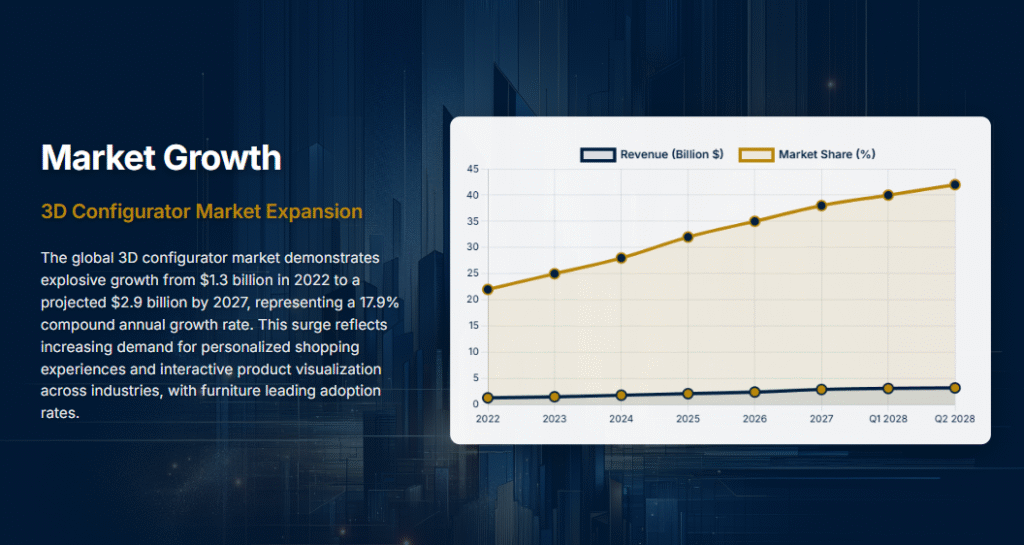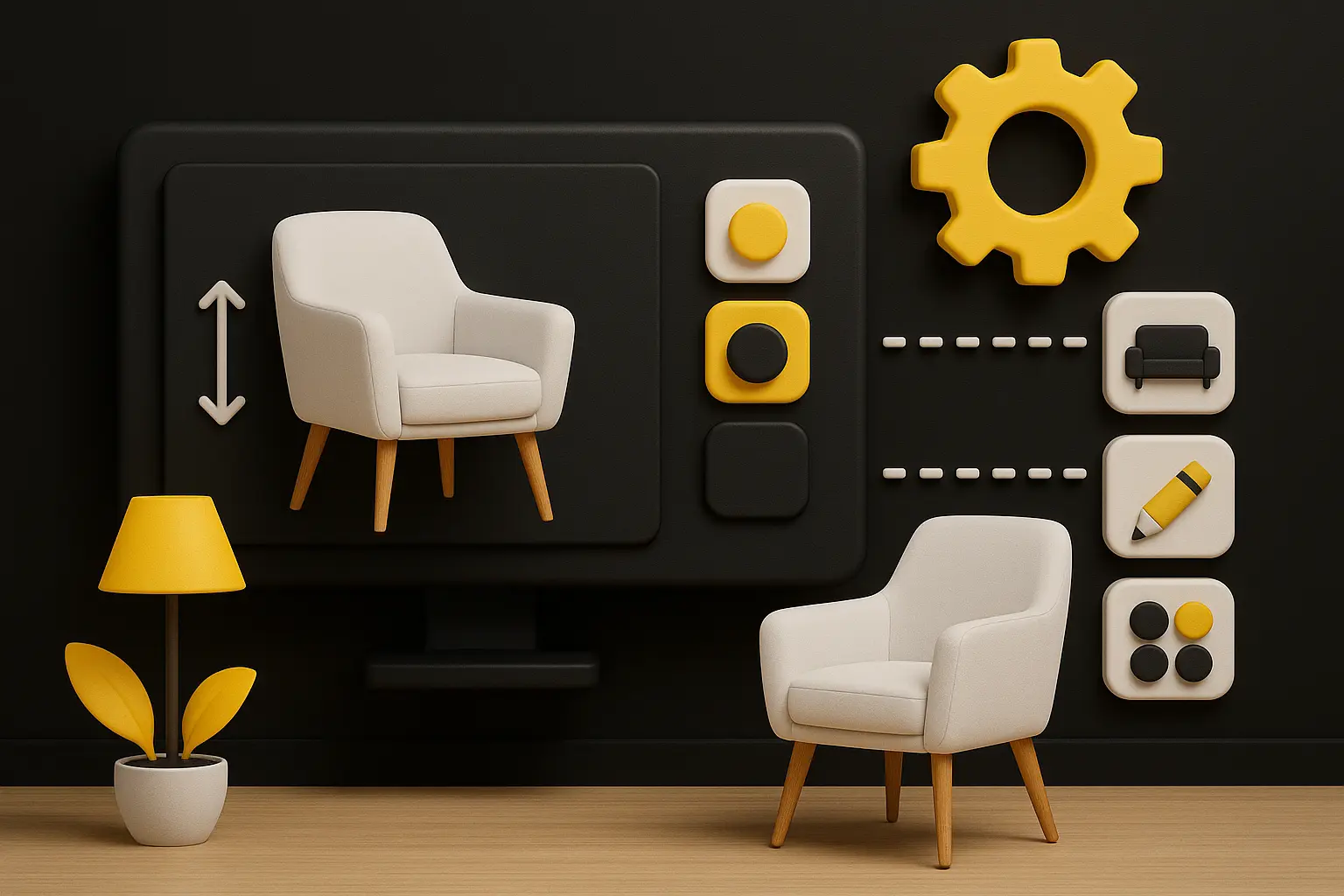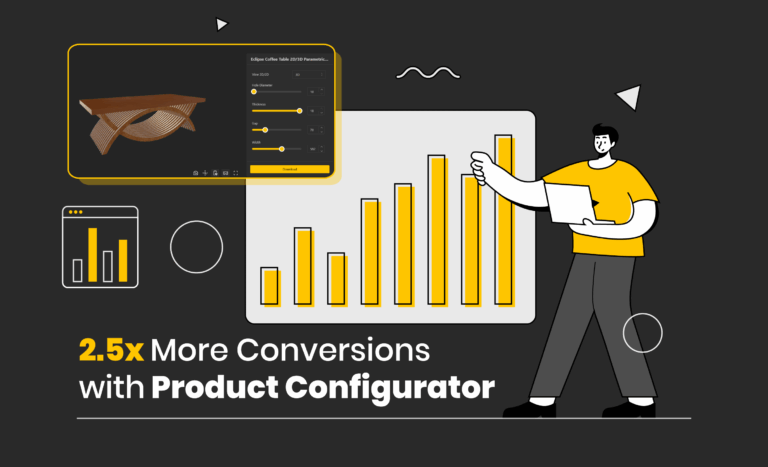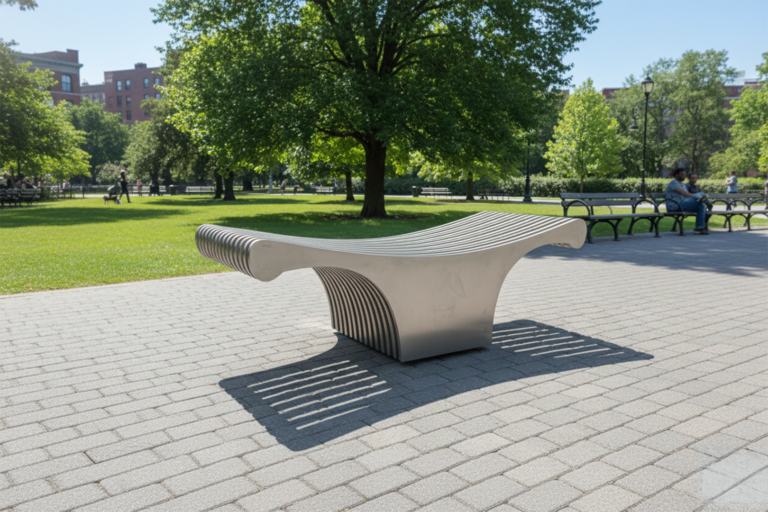Table of Contents
A furniture product configurator is an interactive digital tool that allows customers to personalize furniture online in real time. It enables them to choose dimensions, fabrics, materials, finishes, and features, while previewing their selections in 3D. Many configurators also generate instant price quotes. For manufacturers, this tool streamlines the sales process, reduces costly errors, and provides data-driven insights into customer preferences.
Many businesses don’t collapse because their product quality declines. They collapse because they fail to evolve. For manufacturers in the furniture industry, this warning is especially relevant today. If you’re still relying only on dealers and word-of-mouth, you may be overlooking the biggest shift happening right in front of you: the rise of digital customization, powered by furniture product configurators.
A Conversation That Sparked a Realization
Not long ago, I met with a well-established furniture manufacturer. His company had been built on decades of trust, family values, and a loyal dealer network. When I asked whether he had considered adding a furniture product configurator to his website, he hesitated.
“We already have a good revenue stream,” he said. “People don’t spend three lakhs on a sofa online. My customers prefer in-person interactions through our dealers.”
At face value, this seems reasonable. But it’s also risky. He was evaluating the future using the lens of the present—without recognizing how quickly customer behavior is evolving.
The Market Doesn’t Wait for Comfort Zones
Think about how much has changed in just the last decade. Ten years ago, people hesitated to buy smartphones online. Concerns about authenticity, delivery, and service made them wary. Today, people confidently buy phones worth over ₹1,00,000 online.
What changed? Not the product, but the mindset. Once digital platforms proved reliable, customers embraced them. Businesses that didn’t adapt got left behind.
The same transformation is happening in the furniture industry. Customers are now comfortable making large purchases online—if they feel confident in what they’re getting. They want transparency, personalization, and speed. A furniture product configurator delivers all three.
According to Shopify’s ecommerce trends, customization and visualization tools can experience an average 94% increase in conversions
Why the Old Model Is Losing Relevance
In the traditional model, custom furniture sales depend on:
-
In-person visits
-
Lengthy quoting cycles
-
Manual design updates
It works, but only for a limited audience in a limited geography. It doesn’t scale in today’s digital-first world.
Manufacturers already leveraging furniture product configurators are ahead of the curve. They’re selling high-value furniture online by offering 3D visualization, real-time customization, and instant pricing. They’re not waiting for the demand shift—they’re driving it.
Want to see how it works? Explore BeeGraphy’s Furniture Configurator to experience real-time customization in action.
What a Furniture Product Configurator Actually Delivers
A furniture product configurator isn’t just website software. It becomes the digital backbone of your sales strategy. Here’s why:
1. Your Global Sales Channel
A configurator makes your furniture accessible worldwide. Customers can customize products online, get instant quotes, and order directly—24/7. No sales staff required.
2. A Streamlined Sales Process
No more back-and-forth emails or errors. Configurators automate quoting, visualize every design option, and collect clean order data—saving time and reducing miscommunication.
3. Customer Confidence and Higher Conversions
When customers can see exactly what they’re buying, trust increases. Personalization (size, finish, fabric, features) makes them more likely to commit.
4. Actionable Business Intelligence
Every choice customers make—colors, dimensions, designs—is valuable data. You’ll know what sells, what trends are emerging, and where to focus production.
Debunking the Myth: “People Don’t Buy Expensive Furniture Online”
This belief is outdated. Customers are already buying luxury clothing, high-end electronics, and even cars online. They do this because platforms provide 3D visuals, customization, and trust-building features.
A furniture product configurator brings that same confidence to furniture buying. Customers can preview their exact piece before payment—bridging the gap between showroom and digital experience.
Why Small Manufacturers Gain the Most
Contrary to belief, configurators aren’t just for giant companies. Small and mid-sized manufacturers benefit even more because:
-
They don’t need huge sales teams
-
Configurators act as a digital salesperson
-
It integrates directly with production, bringing clarity and efficiency
If you’re new to the idea, check out Configurator.tech to learn how product configurators work and how they can be adapted for furniture businesses.
The Real Barrier Isn’t Cost, It’s Mindset
What holds businesses back isn’t budget—it’s mindset. Many assume that yesterday’s strategies will work tomorrow. But history (Kodak, Nokia, etc.) shows otherwise.
Furniture businesses that don’t modernize risk losing customers to competitors offering a better digital experience.
Innovate Before You’re Forced To
The best time to adopt a furniture product configurator is when your business is performing well, not when sales are already declining. Early adoption gives you the freedom to invest, train your team, and launch without pressure.
The market data makes this urgent. The global 3D configuration market is projected to grow from $1.3 billion in 2022 to $2.9 billion by 2027, at a 17.9% CAGR (MarketsandMarkets).
What does this mean for you?
-
Rapid adoption is underway. Growth at this scale shows configurators are quickly becoming the norm.
-
Furniture is leading the trend. Personalization and visualization are now expected in big-ticket purchases.
-
Waiting is risky. By the time configurators are mainstream, competitors may already control customer expectations.
These figures highlight one truth: innovate now, while you’re ahead, or risk being forced to later on less favorable terms.

Global market growth of product configurator solutions projected to reach $2.9 billion by 2027
Final Thought: Will You Act, or Be Left Behind?
A product configurator is not a gimmick or a luxury feature. It’s becoming a standard part of the customer journey in furniture retail. If you’re serious about growth, efficiency, and future-proofing your business, you need to start exploring how it fits into your strategy.
To see what kind of results are possible, explore this case study on the ROI of 3D configurators, which highlights how brands are shortening sales cycles and boosting order volumes.
Learn how a product configurator can transform your furniture business
Let your business evolve. Your customers already have.










